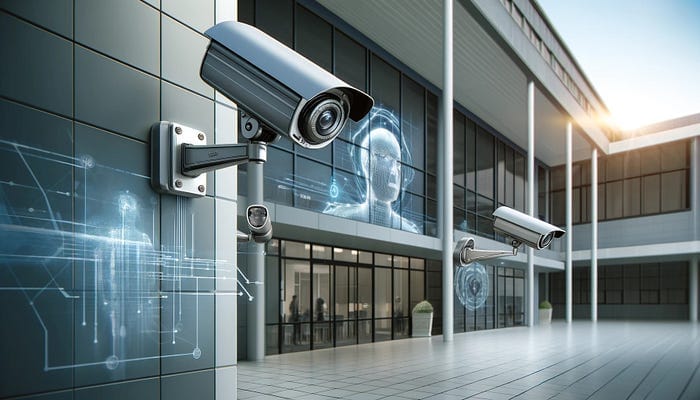Balancing AI-Enhanced Surveillance in Schools with Safety and Privacy

With an increased awareness that school safety is paramount, a school district in Kansas is considering a $5 million grant to install AI-enhanced surveillance cameras in their schools. These advanced systems, primarily developed by ZeroEyes, are designed to identify visible firearms and promptly alert authorities, potentially preventing violent incidents. However, this proposal has sparked a debate over its focus and the potential exclusion of other safety measures and technologies. This short essay looks into the various dimensions of this debate, underlining the need for a balanced approach that enhances safety while safeguarding privacy.
The primary motivation behind adopting AI-enhanced surveillance systems is the potential to enhance school safety significantly. AI-enhanced cameras can detect firearms faster than human observers. By identifying potential threats promptly, these systems can alert authorities faster, potentially preventing or mitigating violent incidents.
Unlike human monitors, AI systems can operate tirelessly and oversee numerous camera feeds simultaneously. This capability increases the overall efficiency of school surveillance efforts, allowing for better coverage and quicker responses.
Advanced surveillance technology may deter potential attackers. Knowing that firearms can be detected swiftly might discourage individuals from attempting to bring weapons onto school premises.
Despite the potential benefits, the proposal has faced criticism and raised several significant concerns. One of the most important concerns with AI-enhanced surveillance cameras is the possible invasion of privacy. Continuous monitoring can lead to fears about collecting, storing, and using data. There is also the risk of misuse, whether by unauthorized access or through policies that may infringe on individual privacy rights.
AI technology is not infallible and can produce false positives, where non-threatening objects are mistakenly identified as firearms. If authorities forcefully respond, such errors can lead to unnecessary panic, disruptions, and potentially dangerous situations.
Focusing primarily on firearm detection might overlook or underfund other critical safety measures and technologies. Comprehensive school safety should involve multiple layers of security, including mental health support, emergency preparedness training, and physical security enhancements.
Over-reliance on technology could be problematic if the system fails or is circumvented. Robust backup plans and alternative safety measures are crucial to ensure continuous protection. To address these concerns, a balanced approach that enhances safety while protecting individual privacy is essential.
Establish clear policies regarding using, accessing, and storing surveillance data. Independent oversight can help ensure these systems are used appropriately and responsibly. Transparent guidelines can also build public trust and reassure the community that their privacy is respected.
Integrating AI surveillance with a broader safety strategy ensures a more holistic approach to school security. This strategy should include physical security measures, mental health resources, and emergency response plans, creating a multi-layered defense system that addresses various aspects of school safety.
Involving the community, including parents, teachers, and students, in discussions about surveillance measures can help address concerns and build trust. Transparency about the system’s capabilities, limitations, and privacy safeguards is essential for fostering a cooperative and informed community.
Continuously evaluating the surveillance system’s effectiveness and impact can help identify areas for improvement and ensure that it adapts to emerging threats and technological advancements. Regular reviews can also help mitigate any unintended negative consequences and enhance the system’s overall reliability.
The proposal to install AI-enhanced surveillance cameras in schools represents a significant step toward improving school safety. However, it raises critical concerns about privacy, false positives, and the potential neglect of other safety measures. A balanced approach that integrates AI technology into a comprehensive safety strategy establishes clear policies and oversight, engages the community, and continuously reviews and improves the system is essential. By doing so, schools can enhance safety while safeguarding the privacy and rights of students and staff, creating a secure and supportive educational environment.
Join Us Towards a Greater Understanding of AI
We hope you found insights and value in this post. If so, we invite you to become a more integral part of our community. By following us and sharing our content, you help spread awareness and foster a more informed and thoughtful conversation about the future of AI. Your voice matters, and we’re eager to hear your thoughts, questions, and suggestions on topics you’re curious about or wish to delve deeper into. Together, we can demystify AI, making it accessible and engaging for everyone. Let’s continue this journey towards a better understanding of AI. Please share your thoughts with us via email: marty@bearnetai.com, and don’t forget to follow and share BearNetAI with others who might also benefit from it. Your support makes all the difference.
Thank you for being a part of this fascinating journey.
BearNetAI. From Bytes to Insights. AI Simplified.
Categories: Technology and Education, School Safety, Artificial Intelligence, Privacy and Security, Public Policy and Governance, Ethical Issues, Community Engagement
The following sources are cited as references used in research for this BLOG post:
Surveillance Capitalism: The Fight for a Human Future at the New Frontier of Power by Shoshana Zuboff
The Age of Surveillance Capitalism: The Fight for a Human Future at the New Frontier of Power by Shoshana Zuboff
Data and Goliath: The Hidden Battles to Collect Your Data and Control Your World by Bruce Schneier
Security and Privacy in Cyber-Physical Systems: Foundations, Principles, and Applications by Housing Song, Glenn A. Fink, and Sabina Jeschke
The Ethics of Artificial Intelligence by S. Matthew Liao
School Security: How to Build and Strengthen a School Safety Program by Paul Timm
Privacy and Freedom by Alan F. Westin
© 2024 BearNetAI LLC